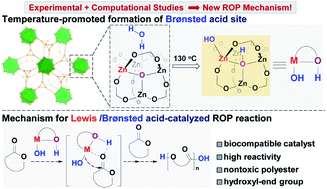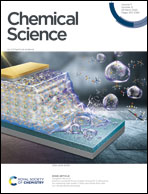The crucial roles of guest water in a biocompatible coordination network in the catalytic ring-opening polymerization of cyclic esters: a new mechanistic perspective†
Abstract
The ring-opening polymerization (ROP) of cyclic esters/carbonates is a crucial approach for the synthesis of biocompatible and biodegradable polyesters. Even though numerous efficient ROP catalysts have been well established, their toxicity heavily limits the biomedical applications of polyester products. To solve the toxicity issues relating to ROP catalysts, we report herein a biocompatible coordination network, CZU-1, consisting of Zn4(μ4-O)(COO)6 secondary building units (SBUs), biomedicine-relevant organic linkers and guest water, which demonstrates high potential for use in the catalytic ROP synthesis of biomedicine-applicable polyesters. Both experimental and computational results reveal that the guest water in CZU-1 plays crucial roles in the activation of the Zn4(μ4-O)(COO)6 SBUs by generating μ4-OH Brønsted acid centers and Zn–OH Lewis acid centers, having a synergistic effect on the catalytic ROP of cyclic esters. Different to the mechanism reported in the literature, we propose a new reaction pathway for the catalytic ROP reaction, which has been confirmed using density functional theory (DFT) calculations, in situ diffuse reflectance IR Fourier transform spectroscopy (DRIFTS), and matrix-assisted laser desorption/ionization time-of-flight mass spectroscopy (MALDI-TOF MS). Additionally, the hydroxyl end groups allow the polyester products to be easily post-modified with different functional moieties to tune their properties for practical applications. We particularly expect that the proposed catalytic ROP mechanism and the developed catalyst design principle will be generally applicable for the controlled synthesis of biomedicine-applicable polymeric materials.



 Please wait while we load your content...
Please wait while we load your content...